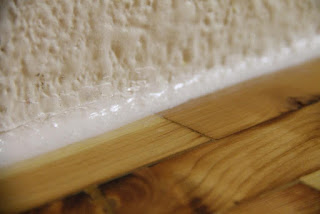Maybe its because Anna Hess and our childhoods and childhood ambitions were so similar, or maybe its because both of our primary life goals havent changed all that much since age nine, but Hess new e-book resonated strongly with us. Her easygoing and open writing style make the book a quick read (weve read several of her books, and finished each in a single session), and for folks like us, for whom homesteading is still a work in progress, its inspiring to read about the journey of someone who has made it for real. And although Hess mentioned that this book is one of her more fluffy productions, there is plenty of practical advice for attentive readers.
 |
| The cover, featuring Anna and her homesteads first veggies. |
The book takes an autobiographical tour of Hess life nearly up to the beginning of her full-time homesteading career. (More details of the interim between then and now are given in her other books.) For aspiring homesteaders (especially those seeking a secluded and rural property on a budget), Hess life lessons are an invaluable treasure. Some of the most pertinent tidbits we gleaned from the book are:
Factors to look for when selecting a tract of land. If the land is $300/acre, theres probably a good reason. It might be polluted (e.g., from mining operations), land-locked, full of invasive plant species, 90% marsh etc. Its also worthwhile to inquire about the level of the water table, especially if you are considering an underground house. In the end, selecting land is an optimization problem with convenience, budget, seclusion, and start-up labor as variables.
How to screen partners/mates to make sure they wont get in the way of are on board with your homesteading goals. Some folks start out with a fiercely independent outlook that theyre going to live off the land and do everything themselves, and dont need no help from no one! (Jake may have been guilty of such aspirations.) But not everyone is Dick Proenneke. A second person can change the whole program in a good way. They contribute a second brain to brainstorms, make the mundane tasks go twice as fast, and will come to look at the cool stuff you find in the woods, for example.
There will be setbacks, so stay flexible and positive! The old farmhouse you planned to salvage might only be fit for condemnation. Deer will devour your first crops. A high water table will thwart your housing plans. Your carefully planned schedule for moving to the property full-time will be demolished by unforeseen events. But keep the ultimate goal in mind, and you will eventually succeed! To return to the previous nugget, a second person can also make it harder to give up when things seem hopeless.
Dont wait until you move to learn the skills youll need. If you want to grow your own food, do what you can with your current circumstances. Start building stuff or prototypes of stuff you plan to use on the homestead, such as cold frames and food dehydrators. It will make the eventual transition way easier. Joel Salatin says the same thing about farming--experience is the key to success.
How to pester utility companies so they will connect your service. One drawback of living in the boonies, depending on your point of view (and since youre reading this on the internet, well assume you would see it as a drawback), is that it can be hard to convince utility companies to connect electric and internet service. With a tight budget (precluding an off-grid setup), personal pride (not relying
too heavily on friends and relatives), and the power of the internet as an income-generating tool, utility connections are, for better or worse, a high-priority item in modern-day homesteading.
There are only two minor criticisms of the book we can conjure. The first is that some of the details on Hess emotions, journal entries, and conversations with her future husband could have been spared. For us, this was the fluffy part of the book. For other readers, these details might resonate with their own experiences, so we cant wholeheartedly dismiss their inclusion as unnecessary.
The second is that some of the photos are blurry and/or unnecessary. Pictures of everyday tasks, like baking cookies at an Aunts house, and pictures of other family members who werent part of the main story line kind of interrupted the flow of the story for us. It was nice to see the faces of the folks who helped out along the way, but wed wager theres a fairly small subset of this books readership for which the photos will have real meaning.
In all, a book worth considerably more than the price of admission, and another great addition to Hess already great series of homesteading e-books. Definitely recommend it.
Have you read this book? Did you have a different impression than we did? Let us know in the comments section below!


















































